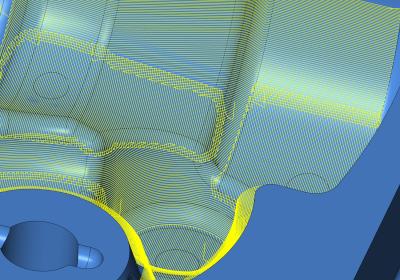
Open Mind Technologies AG has introduced hyperMILL 2019.2, a new version of its advanced, comprehensive CAD/CAM software suite. The latest hyperMILL software has a range of new features including high-precision 3D finishing, 5-axis tangent machining, high-performance turning and new CAD-for-CAM technologies.
"We are pleased to offer our CAM customers with even more powerful finishing, 5-Axis and turning strategies," said Alan Levine, managing director of Open Mind Technologies USA Inc. "In addition, we have improved programming process times, and have also integrated CAD utilities directly into some CAM strategies."
When using the 3D shape Z-level finishing cycle, hyperMILL 2019.2 now offers a “high-precision surface mode” option that ensures ultrasmooth surfaces with tolerances in the micron range. This saves time on post-machining finishing processes, especially for moldmakers. The “Smooth overlap” function also improves surface finish and is available in many cycles. The transition regions for steep and shallow machining have a small overlap including a slightly lifted cutter, resulting in perfect finishes with imperceptible transitions.
In hyperMILL 2019.2, the hyperCAD-S “Global fitting” function is directly integrated into the CAM strategy for 5-Axis tangent machining. With this function, multiple faces can be joined into one face with a controlled ISO orientation. The principle of using CAD elements for CAM programming is also applied for example, to an automatic face extension where the bounding surfaces are automatically extended during programming to improve the edges of the machined surfaces. These dedicated CAD utilities streamline CAM programming and provide tested and proven methodologies.
In the previous version of hyperMILL MAXX Machining, turn-roughing was implemented with trochoidal toolpaths. Now Version 2019.2 offers even greater process reliability for high-performance turning by providing tool life monitoring which restricts tool use by the distance covered, the number of toolpaths or a time limit. If the defined limit is reached, a retract macro is generated automatically and the job ends.
Open Mind has further enhanced its feature and macro technology in the new version to enable more secure and simpler programming. Full-text searching is now available in the macro database and users can define machine and material groups as defaults to make it easier to select macros.
Hole feature linking enables CAD feature model changes to automatically transfer to hyperMILL. Because design changes in CAD are associatively linked with the CAM, users can quickly and securely make updates.
Helpful when working with large parts, hyperCAD-S calculates the workpiece mass and center of mass with a material definition including for solid, mesh and stock models. Also, the “Undercut” function makes it possible to detect undercut areas on components quickly and reliably. In addition, the new “local curvature” analysis function makes it possible to detect curvature radii on components. The minimum curvature radius, which often plays the biggest role, is output immediately, and the best possible lead angles or tool radii for machining curved faces can be determined. This can be beneficial when planning hyperMILL MAXX Machining strategies that use conical barrel cutters (also known as circle segment tools).
Contact Details
Related Glossary Terms
- computer-aided design ( CAD)
computer-aided design ( CAD)
Product-design functions performed with the help of computers and special software.
- computer-aided manufacturing ( CAM)
computer-aided manufacturing ( CAM)
Use of computers to control machining and manufacturing processes.
- micron
micron
Measure of length that is equal to one-millionth of a meter.
- turning
turning
Workpiece is held in a chuck, mounted on a face plate or secured between centers and rotated while a cutting tool, normally a single-point tool, is fed into it along its periphery or across its end or face. Takes the form of straight turning (cutting along the periphery of the workpiece); taper turning (creating a taper); step turning (turning different-size diameters on the same work); chamfering (beveling an edge or shoulder); facing (cutting on an end); turning threads (usually external but can be internal); roughing (high-volume metal removal); and finishing (final light cuts). Performed on lathes, turning centers, chucking machines, automatic screw machines and similar machines.
- undercut
undercut
In numerical-control applications, a cut shorter than the programmed cut resulting after a command change in direction. Also a condition in generated gear teeth when any part of the fillet curve lies inside of a line drawn tangent to the working profile at its point of juncture with the fillet. Undercut may be deliberately introduced to facilitate finishing operations, as in preshaving.

